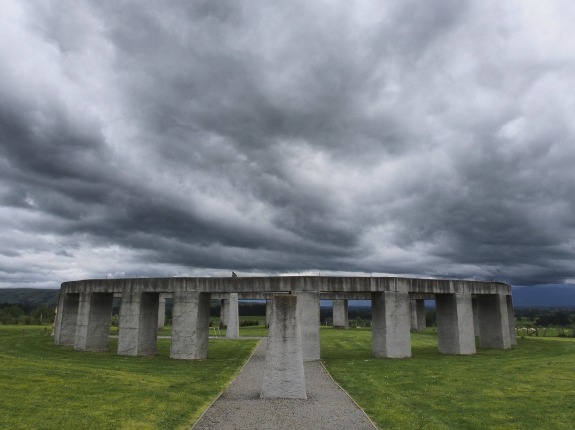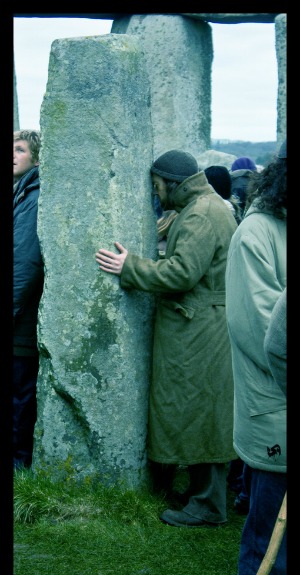The Best Places to See and Celebrate the Winter Solstice
Many temples and monuments were intentionally built to face, frame or otherwise “welcome” the rising winter solstice sun
In a widely anticipated annual phenomenon, the solstice sunrise appears through the entryway of the temple of Karnak, one of hundreds of Egyptian sites built in alignment with celestial events. Photo courtesy of Juan Antonio Belmonte.
Tomorrow, a person standing anywhere along the Tropic of Capricorn can look up when the clock strikes noon and observe that the Sun is hovering directly overhead. That means easy sunburns and the start of summer to our friends in Sydney, Santiago, Cape Town and Auckland, for December 21 is the southern summer solstice.
But north of the Equator, we’re about to face-off with the shortest and darkest day of the year—our winter solstice. Where I live, in San Francisco, at about 37 degrees north latitude, the Sun will hit its meager noontime zenith at just 30 degrees above the southern horizon. And farther north, in Glasgow, at 56 degrees latitude, the situation is grimmer; the Sun will scrape out seven hours of daylight while peaking at noon only 11 degrees above the horizon. And in Fairbanks, at 65 degrees north latitude, the outlook for the solstice is truly bleak—for the Sun will barely make an appearance at all, rising to no higher than two degrees above the southern horizon and providing less than four hours of dusky daylight before dipping again behind the Earth.
For ancient people, this dark time of year, of shortening days and a sinking sun, was a gloomy one, posing the greatest threat of freezing or famine—especially in high-latitude locations. But the solstice, though the shortest, darkest day of all, also marked the turnaround toward spring and summer. Thus, December 21 and December 22 (the exact solstice date varies year by year) were days to rejoice. Many people around the world—especially, it seems, in Egypt and Europe—built temples and monuments in recognition of the winter solstice. They aligned these structures to face, frame or otherwise “welcome” the rising Sun as it emerged from the horizon, and today viewers may still see the beautiful visual effects these ancient architects created using Sun and stone. Following are several places to see the solstice in action.
England, Glastonbury Tor: At 51 degrees north latitude, Glastonbury Tor is a man-made mound in southern England that historians believe was built to celebrate the Sun and the path it takes through the sky. On the winter solstice, a person standing on the nearby Windmill Hill can watch as the rising Sun appears to roll along the slope of the mound from base to top, where the ruins of St. Michael’s Church still stand.

The ruins of St. Michael’s Church stand atop Glastonbury Tor. On the winter solstice, the Sun appears to rise at the base of the hill and roll upward to the summit before lifting off into the sky. Photo courtesy of Flickr user saffron100_uk.
Mexico, Chichen Itza: Three months ago, I discussed the importance of this ancient Mayan site as it relates to the equinoxes—on which two days a shadow, cast down the stairway of the Kukulcán pyramid in the late afternoon, creates the spectacular image of an undulating serpent. On the winter solstice, the Sun itself is the star of the occasion, rising at dawn (it always does, doesn’t it?) and lifting upward along the edge of the pyramid. To a person facing the western side of the monument, the rising Sun appears to roll up the pyramid’s edge before lifting off into the tropical deep-winter sky.
Egypt, Karnak Temple: On December 21, viewers inside the Karnak Temple can see the Sun rise dramatically in the entryway, between the high walls of the ancient monument. For a few moments, the Sun’s rays gleam through the pillars and chambers—including the Sanctuary of Amun—before the event passes, and morning commences on this shortest day of the year. Arnak is just one of many sites like it in Egypt. A survey of 650 Egyptian temples, conducted by scientist Juan Belmonte of the Canaries Astrophysical Institute, has led to the conclusion that most of the sites were built in recognition of celestial events—especially sunrise on the equinoxes and solstices.
England, Stonehenge: The makers of England’s most famous rockpile certainly had something special in mind when they arranged the giant slabs as they did, but the site remains a mystery. Some people today believe the winter solstice sunset inspired the arrangement of the stones, but overall, evidence is spotty that the huge slabs of Stonehenge are aligned to celestial events. Nonetheless, Stonehenge fanatics want in on the party. Last winter, 5,000 people visited Stonehenge on the solstice, and many are expected tomorrow—though officials have voiced concern over the impending crowds. And as if crashing the winter solstice party wasn’t enough, pagans and partiers from miles around convene at Stonehenge for the summer solstice, too. In 2011, 18,000 of them hooted and hollered as the Sun rose just before 5 a.m., and 14,000 returned for the same occasion in 2012. This website concedes that the builders of Stonehenge did not likely have any summer solstice symbolism in mind.
New Zealand, Aotearoa Stonehenge: New Zealand is a modern austral society with ancient roots in the boreal world, and so what the Kiwis may lack in paleoarchitecture they may simply build anew out of wood, wire and concrete. So was born Aotearoa Stonehenge near Wellington, a modern interpretation of the original Stonehenge. Designed specifically to accommodate the site’s latitude and longitude, the circular arrangement includes 24 pillars that create windows through which visitors may watch the appearance of important stars and constellations of the southern sky as they rise from the horizon. Additionally, a 16-foot-tall obelisk points toward the celestial south pole. The structure was built by volunteers with the Phoenix Astronomical Society, who toiled for 11,000 hours over 18 months to complete the job. The henge was finished in 2005 and already has become a noted site for seeing the sunrise on the austral summer solstice.

Clouds frequently darken the New Zealand sky, yet the recently built Aotearoa Stonehenge—a lookalike of the original—has become a popular gathering spot for solstice celebrators. Photo courtesy of Flickr user jimmy.kl.
The end of the world? The solstice of 2012 will be a particularly exciting one since the day also happens to be the scheduled end of the world, according to many spiritualists—especially those fixated on interpretations of the Mayan calendar. But scientists with NASA have publicly countered, announcing that there is no evidence of impending doom. The United States Geological Survey also concluded in a recent blog article that the world will go on after tomorrow’s solstice. Phew!
/https://tf-cmsv2-smithsonianmag-media.s3.amazonaws.com/accounts/headshot/Off-Road-alastair-bland-240.jpg)


/https://tf-cmsv2-smithsonianmag-media.s3.amazonaws.com/accounts/headshot/Off-Road-alastair-bland-240.jpg)